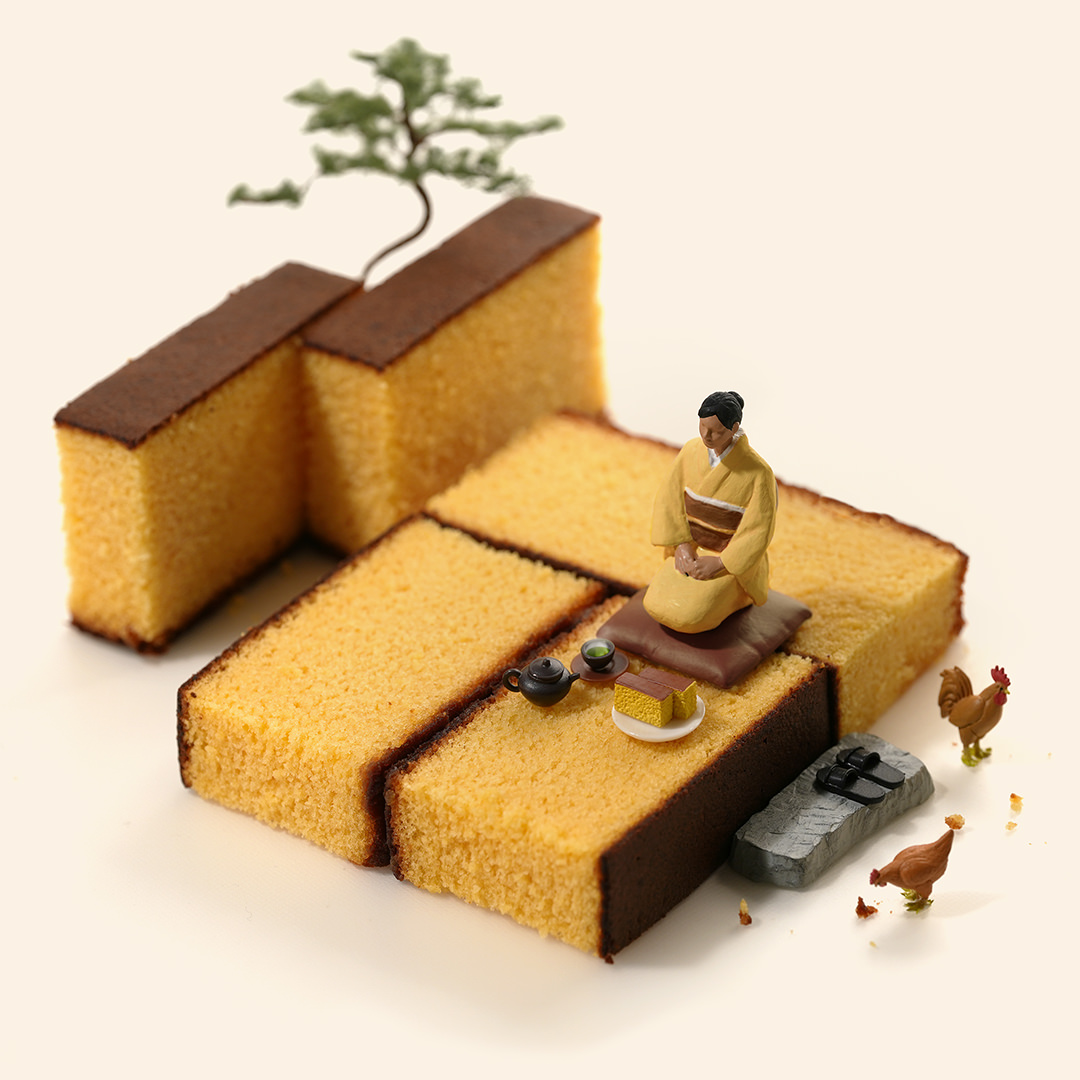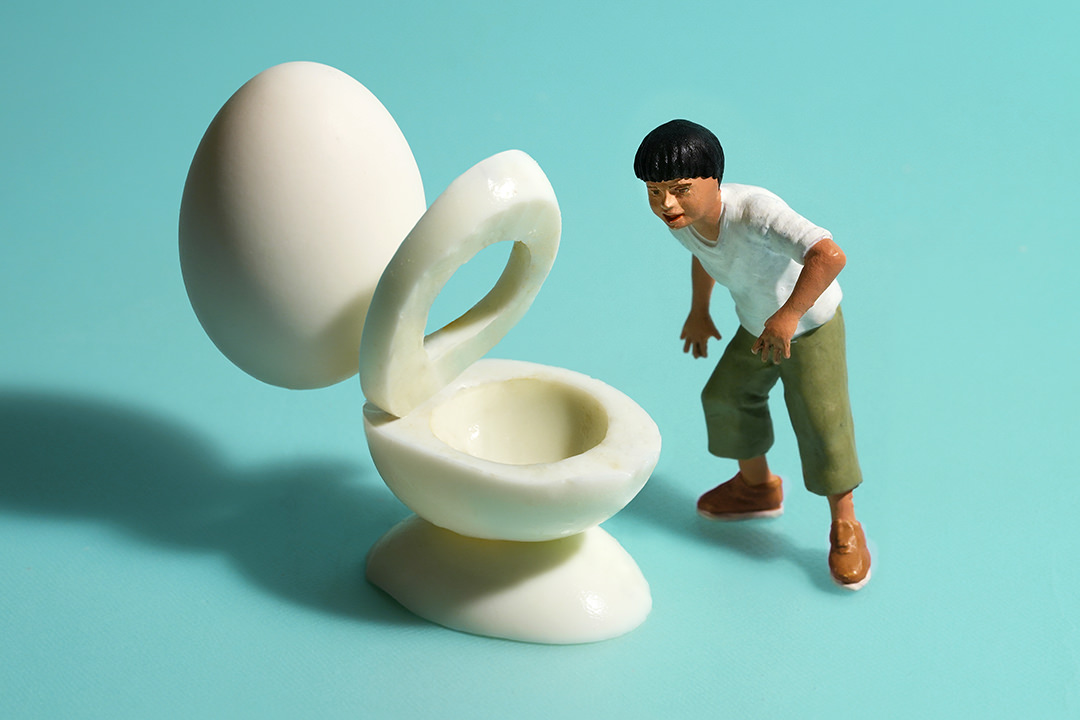Tatsuya Tanaka wields godly power. As the architect of an alternative world where popcorn plays the role of clouds, castella becomes tatami and tatami turns into rice paddies, Tanaka is in complete creative control. But with such power comes great responsibility, and he’s very careful with how he applies it. His pint-sized worlds are a place of escapism, and they reach audiences across the globe.
In fact, the charming creations that result from his fertile imagination are carefully designed to tie bonds of unity across the divided real world.
Talking with Tanaka, we discover that the man behind these whimsical worlds is as charming as his creations. Speaking from his studio and surrounded by floor-to-ceiling drawers filled with the materials he uses for his works, he shares the amount of thought and consideration that goes into each one. He’s perfected that process over the past 12 years.

“Wave of Words”
Maker of Worlds
Tanaka is a photographer of mitate, an art form that requires the admirer to look beyond the final composition to discover visual puns and other layers of meaning hidden in plain view. It’s a role he’s done better than anyone else for over a decade. The mitate he photographs are his tiny worlds, for which he references miniature — the small representation of something — and diorama, which refers to 3D depictions of scenes or environments.
Every single day, Tanaka crafts a new mitate using whatever comes to mind. Recent scenes include a minuscule man who crafts large bowls from mushroom caps, a tiny stag deer roaming a forest of broccoli and a scene from the Titanic. The artist has brought mitate to life daily since 2011 through his Miniature Calendar project. What started as a hobby grew exponentially via his social media accounts, including Instagram, where he has over 3.7 million followers.

“Japanese Style Room”
Making the Mitate
Each mitate, from selecting parts to arranging them and shooting the completed scene, takes around four hours. Tanaka looks through his calendar notes to pick an idea for the day, then gets to work, mainly using simple objects. These objects must be recognizable worldwide, so he avoids using “fancy” items like novelty stationery or funny-shaped accessories. Dolls and other props he buys and then modifies to fit his vision. He did trial a 3D printer during the pandemic but realized that altering something he’d purchased was both quicker and easier. Creating with his hands also adds to the charm of his miniature worlds.
Once he’s finished making the mitate for the day, he has a very specific quality check: “I ask my sons what they think,” he says. “If they don’t know what it’s meant to be or their reaction isn’t positive, I’ll think twice before posting it. It’s a good way to get an objective opinion, and sometimes they give me new ideas.” Asking his sons to check, he explains, enables him to judge if a piece will be easy to understand for his global audience.

“Rice Clouds”
Mitate Every Day
Tanaka rarely takes days off because of the timely nature of his posting. He takes the creation of his mitate very seriously, checking the news every day. “I’ll hold off on a particular idea if something related to the topic has happened in the world the day before. I haven’t posted anything to do with fires for a long time.”
He monitors reactions to pieces, noting which are popular and which are not, and has learned a lot in the process. Certain concepts, he finds, translate better than others. A 2021 mitate of a boater who was, according to the Japanese title, “cutting nails, not wind,” went down poorly with the global audience. English comments expressed disgust at the scene, which consisted of a nail-clipper boat whipping up waves of chopped nails as it sped gaily over the water. Even though clipping nails while watching TV is fairly normal in Japan, he found that it wasn’t necessarily the case elsewhere. Similarly, mitate showing shark fins are off the agenda, as is anything to do with dolphins.

“Egg Toilet”
Learning with Experience
Throughout the years, Tanaka noticed several important changes, one being the reactions of his followers. He considers the titles of his works to be very important, and many of the Japanese versions involve wordplay.
As the years have passed, his followers have grown accustomed to the puns, offering critique and alternatives to Tanaka’s titles. “I’m surprised by how good they are,” he tells me. “When I have an exhibition and revisit works, I occasionally change them thanks to a comment by a follower. My titles are transient, and it helps preserve longevity by remaining open to change.”
Tanaka’s miniature mitate world is not only a place of longevity, it is a place of unity. “Creating something that can be understood by people from many different countries brings to light the fact that we are all human, irrespective of our religion or nationality,” he says. He continues, imparting knowledge gained over more than 10 years spent searching for commonalities across cultures: “Everyone goes to the bathroom, eats and sleeps, and once we get to the bottom of what is similar, no matter what religion you are, you can get along. In the current world, people talk a lot about diversity. They want us to respect differences,” he comments. “But why don’t we look for the things which unite us?”
Grab Tanaka’s Miniature Calendar or a book.
This article was originally published in the TW November-December 2023 issue









